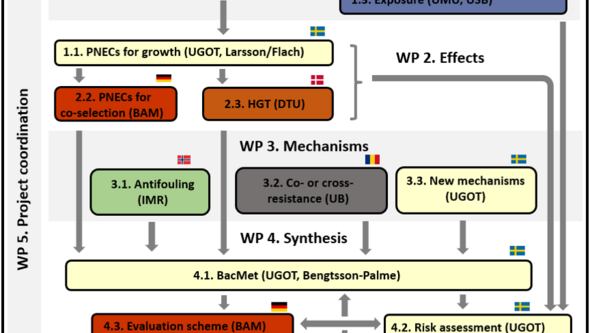The research project is organized in five work packages (WPs)
Brief descriptions of the objectives of the WPs
The WPs are (1) Exposure, (2) Effects, (3) Mechanisms, (4) Synthesis and (5) Coordination
The main objectives of the WPs are listed below
Exposure
1) Prioritize antibacterial biocides to be investigated based on existing databases on sales, uses and detection in aquatic environments
2) Develop stateof-the art chemical analysis protocols for a range of antibacterial biocides, applicable to different sample types, and
3) Generate screening data for the presence and levels of antibacterial biocides in different environmental matrices from a set of different aquatic ecosystems in Europe and Africa
Effects
1) Generating a dose-response matrix for a large number of biocides and bacterial species in order to obtain Predicted No Effect Concentrations (PNECs) for growth that will also be protective against AB resistance co-selection,
2) Directly assesssing co-selection by competition experiments in complex aquatic communities using a subset of biocides, and
3) Quantify the potency of selected biocides to induce horizontal transfer of AB resistance genes via conjugation and transformation.
Mechanisms
1) Uncover the incidence and mechanisms of AB resistance driven by metal-based antifouling agents used in international maritime traffic and marine aquaculture,
2) Providing a first description of the predominant co- and cross-resistance mechanisms in bacterial isolates from aquatic ecosystems in Europe and Africa,
3) Identifying the genetic context and basis for resistance to several biocides using a functional (meta) genomics approach combined with exploration of public genomic data.
Synthesis
1) Incorporating extensive data on selective concentrations and co-selection opportunities into the BacMet database to make it useful for practical risk assessment and management,
2) Performing a preliminary assessment of risks for biocides to promote AB resistance in aquatic environments based on generated exposure and effect data,
3) Producing an evaluation scheme in collaboration with relevant authorities on how resistance risks formally could be incorporated in existing regulatory frameworks.
Coordination
The objective of WP5 (Coordination) is to coordinate research and communication activities, within and outside the consortium. Optimal coordination ensures that we make the most out of available resources and competence, that we capture and consider urgent research gaps and needs from society, and that we communicate results in a way that efficiently reaches the scientific community and stakeholders, facilitating rapid transitions into policies.
